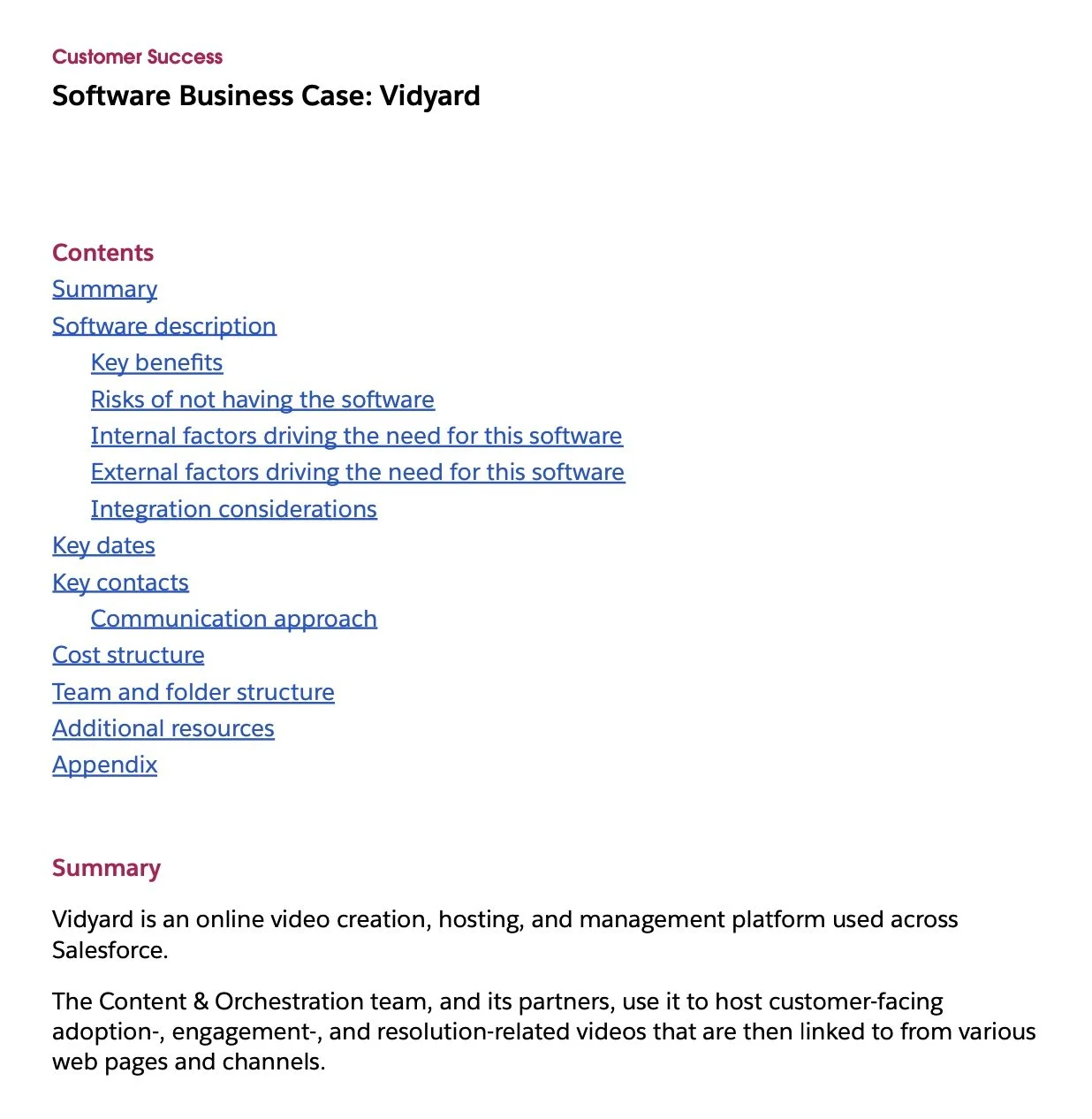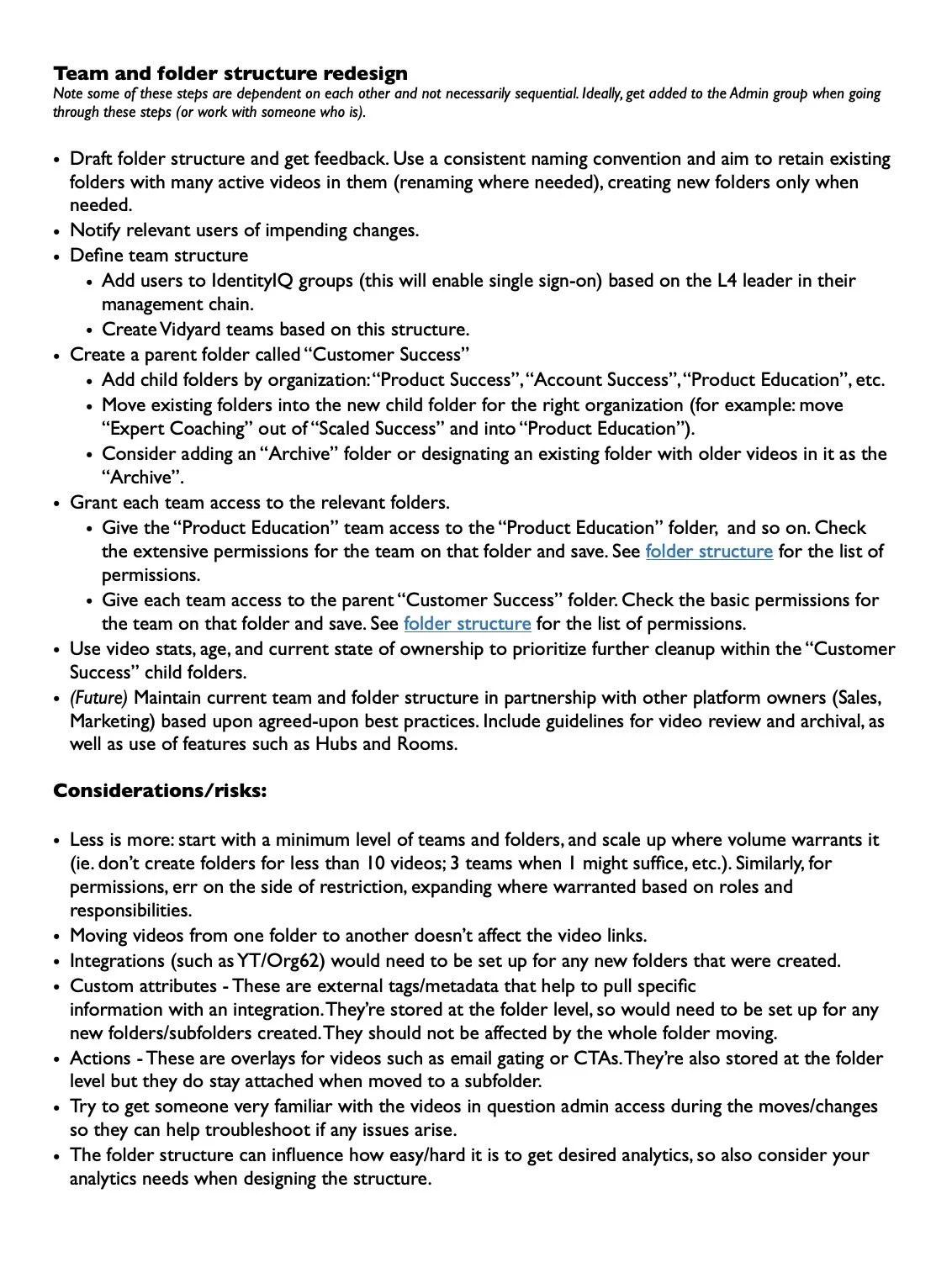Goals:
Work cross-functionally and with the vendor to clean up our instance ahead of contract renewal.
Implement preliminary governance to prevent regressing to the current state.
My role:
I represented the Customer Success organization since I ran the platform management service in Content Services. Specific responsibilities included:
Designing and implementing team and folder structure for Customer Success videos in Vidyard.
Documenting and sharing the process for other organizations to adapt.
Documenting preliminary governance guidelines to hand off to a new hire that would be managing the instance after contract renewal.
Edit communications going out to internal users about the updates/changes.
Excerpt from the new business case
Deliverables:
A workbook detailing our user count and new folder structure.
An up-to-date business case detailing our use, user and video volumes, cost structure, rationale for the new folder structure, etc.
A Slack canvas shared with the channel charting our decision history (ex: what constitutes an “inactive” user), key milestones, stats on cleanup completed so far, and useful contacts.
Results:
After auditing our users and videos, the group made the decision to remove more than 5,000 inactive users and archive more than 120,000 videos.
I created and rolled out a logical team structure and set up relevant folders with corresponding permissions by team. This enabled our use of single sign-on instead of provisioning accounts on a per-license basis.
Before:
Video content grew organically and without governance in Vidyard over several years. Hundreds of licenses were allocated to employees who were no longer producing videos or who had left the company. Thousands of videos hadn’t been viewed in years. The platform didn't have a central owner and so there was no defined structure or governance by team or folder - there were hundreds of folders without any consistent or predictable structure!
After:
For Customer Success, we went from 50 teams in Vidyard to 6; from 9 folders in various parents and at various levels to 1 parent folder containing 6 child folders, representing the organizational leadership structure. This made enhanced reporting possible, because we could now filter by folder get a view of videos produced by Customer Success at various levels of detail. We also designated an admin for the organization to oversee access requests and maintain the folder structure.
Process:
Over a series of meetings with a cross-functional group, we decided on criteria for deactivating users and archiving videos and determined when and how to keep current users aware of this work. The vendor’s support team helped us carry out the bulk actions. After the initial cleanup, we decided to test the next steps with one group, Customer Success, before scaling it more broadly to bigger groups.
Outlining the new process for organizing teams and folders
I inventoried existing Customer Success videos and folders to decide what a new structure could look like: I proposed organizing users into teams based on their management chain, and having a parent folder for each team, which relevant existing folders and lone videos would be moved into. Instead of having folders for different programs in a flat structure with access granted to one folder at a time, this would mean all videos created by a specific organization would be accessible in one place.
This struck me as a scalable folder structure that would support a logical permission structure as well, since we were trying to set up single sign-on for users instead of requiring individual log-ins. Each team would have extensive permissions to their corresponding folder, but also limited permissions on other child folders within the organization’s parent folder. This means they can view and download videos from other teams’ folders within Customer Success, but not edit them directly.
Feedback confirmed this was a sound approach and proved a good way to stress-test the conceptual structure. Since there were integrations and customizations on some of the folders, it was important to confirm there would be limited disruption to the video producing teams as some folders were being moved.
I worked with a security analyst in Sales to create the new teams and set them up for single sign-on. I then created new folders and assigned permissions. Throughout, I made sure to share updates with stakeholders in Customer Success and document these processes for other organizations to follow.
What I’d do differently:
Feedback from both stakeholders and the cross-functional group was very positive, but a sudden reorg meant I had to hand off platform management to another team. I knew anecdotally that the new structure and my recommendations were implemented, but I couldn’t see how governance held up over time. Given more time, I would have preferred to check in a few times after the initial roll-out and get more feedback, identify iterations or updates to the new structure, and so on.

